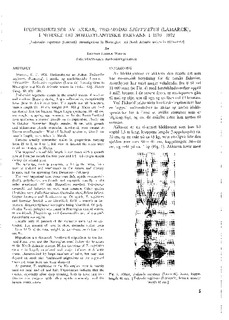| dc.description.abstract | Todarodes sagittatus occurs in the coastal waters of western and northern Norway during August—December, exceptionally from June to April next year. The squids are all immature, mantle length 23—35 cm, weight 200—900 g. Males are 1—3 cm shorter than the females. Single larger specimens, 36—41 cm, are caught in spring and summer. — In the Faroe-Shetland area specimens measured 23—29 cm in September, 19—37 cm . a October—November. Single females, 46 cm, with gonads and nidamental glands somewhat developed, were caught in November—December. West of Ireland specimens, 23—27 cm mantle length, were taken in March. Females usually outnumber males in proportions varying from 23 to 1, to 9 to 1, but west of Ireland the sexes were equal in number in March. The supposed normal life length is two years with a growth rate of 3 cm per month the first year and 1.2—1.6 cm per month during the second year. The spawning area is supposed to be in the ocean from west of Ireland and southwards to the Azores and Canary lands, and the spawning time December—February. The most important food items were fish, squids, euphausiids (krill), polychaetes, amphipods and copepods, usually in the order mentioned. Of fish, Maurolicus muelleri, Trisopterus esmarcki. and Sebastes sp. were most common. Other species identified were Pollachius virens,Gadiculus thori, Belone belone, Clupea harengus and Benthosema sp. Of squids, T. sagittatus and Gonatus fabricii were identified. Krill is sometimes important, Meganyctiphanes norvegica being identified. Of polychaetes Nereis pelagica was found in Norwegian coastal waters, of amphipods Themisto sp. and Gammarellus sp., of copepods Pareuchaeta norvegica. Usually only 10 percent of the stomachs were full or distended. The amount of food in these stomachs varied from 1% to 12% of the total weight, in the others, much less than one %. Migration are discussed. Northward migrations to the Iceland-Faroe area and the Norwegian coast follow the branches of the North Atlantic current. Major invasions of T. sagittatus seem to be largely correlated with major influxes ot Atlantic water, characterized by latge numbers of salps, but may also depend on stock size.Southward migrations to the supposed spawning areas have not been observed. At present, T. sagittatus at the Norwegian coast is mainly used for meal and oil and bait. Experiments indicate that the species, especially after deep freezing, both in taste and tenderness can compete with other squids commonly used for human consumption. | en_US |
